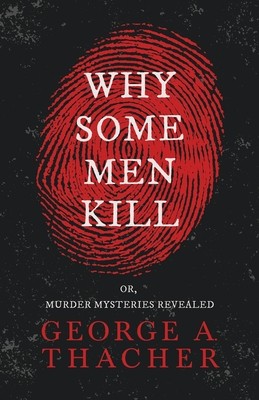
- We will send in 10–14 business days.
- Author: George A Thacher
- Publisher: Read & Co. History
- ISBN-10: 1444666150
- ISBN-13: 9781444666151
- Format: 14 x 21.6 x 0.9 cm, minkšti viršeliai
- Language: English
- SAVE -10% with code: EXTRA
Why Some Men Kill - or, Murder Mysteries Revealed;With the Essay 'Spontaneous and Imitative Crime' by Euphemia Vale Blake (e-book) (used book) | bookbook.eu
Reviews
Description
"Why Some Men Kill - or, Murder Mysteries Revealed" is a 1919 work that explores the subject of criminal psychology with reference to notable historical cases of horrific murders in America. A chilling investigation into the age-old question of why people commit murder that is not to be missed by those with an interest in psychology and criminology. Contents include: "The Delinquent Moron", "Psychology of Confessions of Crime", "The Murder of William Booth and the Conviction of William Branson and Mrs. Booth", "William Riggin Shows Warden Murphy Where He Concealed the Revolver", "Appeal to the Public for the Release of William Branson and Mrs. Booth", "The Murder of Mrs. Daisy Wehrman and Her Child", "The Hair Found in Mrs. Wehrman's Dead Hands", "John Sierks' Letters About the Murder", etc. Read & Co. History is proudly republishing this classic work now in a brand new edition complete with the introductory essay 'Spontaneous and Imitative Crime' by Euphemia Vale Blake.
EXTRA 10 % discount with code: EXTRA
The promotion ends in 22d.14:26:13
The discount code is valid when purchasing from 10 €. Discounts do not stack.
- Author: George A Thacher
- Publisher: Read & Co. History
- ISBN-10: 1444666150
- ISBN-13: 9781444666151
- Format: 14 x 21.6 x 0.9 cm, minkšti viršeliai
- Language: English English
"Why Some Men Kill - or, Murder Mysteries Revealed" is a 1919 work that explores the subject of criminal psychology with reference to notable historical cases of horrific murders in America. A chilling investigation into the age-old question of why people commit murder that is not to be missed by those with an interest in psychology and criminology. Contents include: "The Delinquent Moron", "Psychology of Confessions of Crime", "The Murder of William Booth and the Conviction of William Branson and Mrs. Booth", "William Riggin Shows Warden Murphy Where He Concealed the Revolver", "Appeal to the Public for the Release of William Branson and Mrs. Booth", "The Murder of Mrs. Daisy Wehrman and Her Child", "The Hair Found in Mrs. Wehrman's Dead Hands", "John Sierks' Letters About the Murder", etc. Read & Co. History is proudly republishing this classic work now in a brand new edition complete with the introductory essay 'Spontaneous and Imitative Crime' by Euphemia Vale Blake.


Reviews